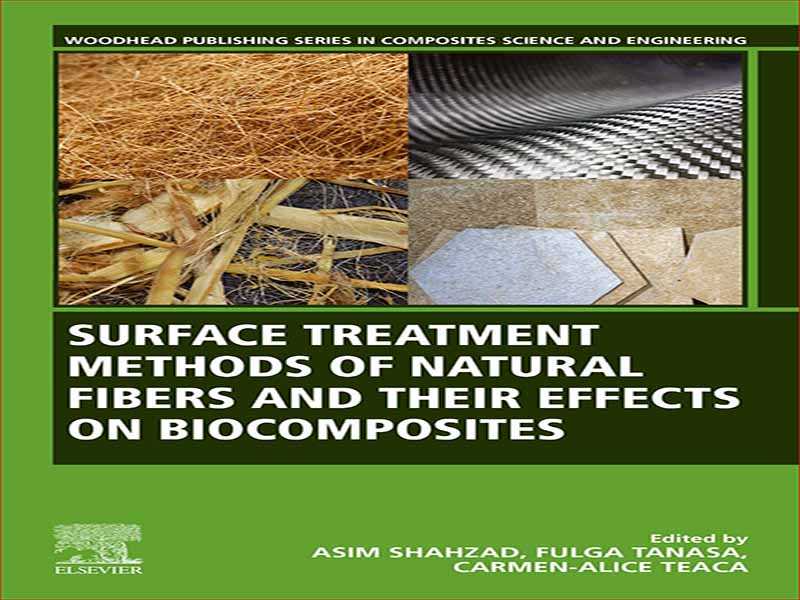- عنوان کتاب: Surface Treatment Methods of Natural Fibers and Their Effects on Biocomposites
- نویسنده: Asim Shahzad
- حوزه: کامپوزیت
- سال انتشار: 2022
- تعداد صفحه: 258
- زبان اصلی: انگلیسی
- نوع فایل: pdf
- حجم فایل: 21.0 مگابایت
استفاده از الیاف طبیعی، به طور کلی، و به عنوان تقویت کننده در بیوکامپوزیت ها، به طور خاص، در دو دهه اخیر به طور پیوسته در حال افزایش بوده است. این بیوکامپوزیت ها کاربردهای بی شماری در صنایع خودروسازی، بسته بندی، کالاهای مصرفی و ساختمانی پیدا می کنند. کنفرانس سالانه زیست کامپوزیت ها در کلن آلمان، این رشد را با اهدای جوایز به خلاقانه ترین محصولات ساخته شده از بیوکامپوزیت ها جشن می گیرد. برندگان هشتمین کنفرانس زیست کامپوزیت ها در سال 2019 منعکس کننده تنوع چنین کاربردهایی هستند. Golden Compound از آلمان با کپسولهای قهوه کمپوستپذیر خانگی خود مقام اول را کسب کرد، KNNCcellulose از هلند با دانههای بیوکامپوزیت ساخته شده از کاغذ توالت بازیافتی مقام دوم را به خود اختصاص داد و Bcomp از سوئیس با PowerRibs خود، یک ماده کامپوزیت ساخته شده از الیاف طبیعی به مقام سوم دست یافت. – کاربردهای عملکردی در ساخت و سازهای سبک وزن برندگان قبلی این جوایز شامل طیف متنوعی از محصولات مانند تابوت، آلات موسیقی و گلدان بودند. در بخش خودرو، بیوکامپوزیت ها عمدتاً برای کاهش وزن کلی خودروها (اجزای داخلی مانند پشتی سر، پشتی صندلی، تکیه گاه بازو، پانل درها و آستر صندوق عقب) استفاده می شوند. همچنین، زمان چرخه کوتاه تر، مقاومت در برابر خراش و ردپای کمتر CO2 نقش مهمی در کاربردهای فنی بیوکامپوزیت ها در صنعت خودرو دارد. در این حوزه تقاضا ادامه دارد و کم و بیش ثابت است. به گفته مؤسسه nova از آلمان (nova-Institut f€ur politische und €okologische Innovation GmbH) هر ساله حدود 80000 تن چوب و الیاف طبیعی در 150000 تن قطعات کامپوزیتی خودروها و کامیونهای ساخته شده در اروپا استفاده میشود. . تجزیه و تحلیل آن تخمین می زند که اکنون هر خودروی سواری اروپایی به طور متوسط حاوی 1.9 کیلوگرم الیاف طبیعی و 1.9 کیلوگرم الیاف چوب است و از نظر فنی، حجم بسیار بالاتری امکان پذیر است. یکی دیگر از بازارهای بالقوه که اخیراً توسعه یافته است، از بیوکامپوزیت ها برای ماشین های الکتریکی کوچک جدید و ماشین های مسابقه ای استفاده می کند. در صنعت ساختمان، عرشه و نرده کامپوزیت چوب-پلاستیک (WPC) برای اولین بار در آمریکای شمالی در دهه 1980 به عنوان یک روش خوب برای بازیافت چوب و پلاستیک توسعه یافت و بیشترین تقاضا را برای مواد WPC در کاربردهای عرشه در سراسر جهان ایجاد کرد. از آن زمان ادغام قوی در بازار دکینگ WPC رخ داده است.
The use of natural fibers, in general, and as reinforcement in biocomposites, in particular, has been increasing steadily in the last two decades. These biocomposites are finding myriad applications in automotive, packaging, consumer goods, and construction industries. The annual biocomposites conference in Cologne, Germany, celebrates this growth by awarding the most innovative products made of biocomposites. The winners of the 8th Biocomposites Conference in 2019 reflect the diversity of such applications. Golden Compound from Germany won the first place with its certified home compostable coffee capsules,KNNCellulose from the Netherlands took second place with their biocomposite granulatesmade from recycled toilet paper, andBcompfrom Switzerland achieved third place with their PowerRibs, a composite material made of natural fibers for high-performance applications in lightweight construction. Previous winners of these awards have included diverse range of products like coffin, musical instruments, and vase. In the automotive sector, biocomposites are primarily used for reducing the overall weight of cars (interior components like headrests, seat backs, armrests, door panels and trunk liners). Also, shorter cycle times, scratch resistance and a lower CO2 footprint play a crucial role in the technical applications of biocomposites in the automotive industry. In this area, the demand is ongoing and more or less stable. Some 80,000 tonnes of wood and natural fibers are already employed in the 150,000 tonnes of composite parts for cars and trucks made in Europe each year, according to the nova-Institut from Germany (nova-Institut f€ur politische und €okologische Innovation GmbH). Its analysis estimates that every European passenger car now contains an average of 1.9 kg of natural fibers and 1.9 kg of wood fibers, and from a technical point of view, much higher volumes are possible. Another potential market, which has been developed recently, uses biocomposites for small new electric cars and racing cars. In the construction industry, wood-plastic composite (WPC) decking and railing were first developed in North America in the 1980s as a good way of recycling wood and plastics, and they created the greatest demand for WPC materials in decking applications throughout the world. A strong consolidation has since taken place on the WPC decking market.
این کتاب را میتوانید از لینک زیر بصورت رایگان دانلود کنید:
Download: Surface Treatment Methods of Natural Fibers and Their Effects on Biocomposites

































نظرات کاربران